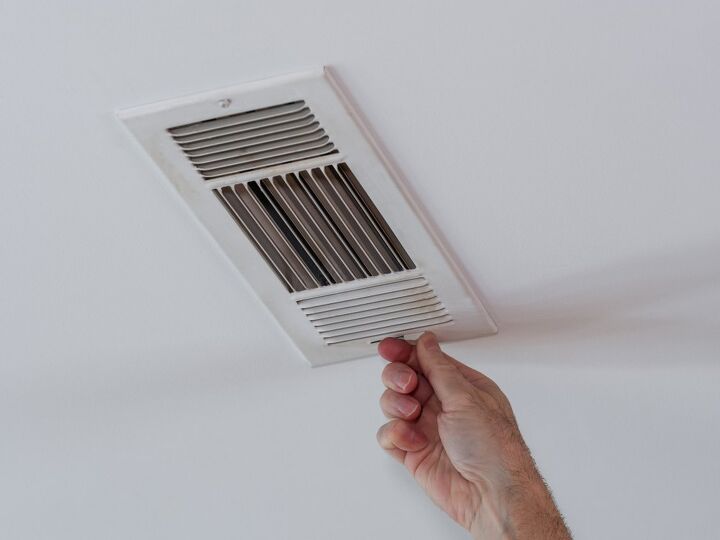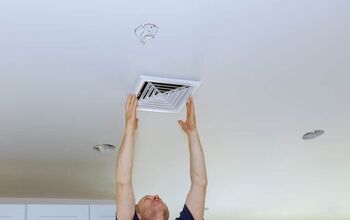Furnace Blowing Cold Air Only At Night?

As the days get shorter and the nights long and cold, a reliable furnace becomes an essential fixture in the home. When the temperatures dip below freezing, your furnace is even a lifesaver. It helps keep you and your home warm, and with the assistance of your thermostat, you stay in a temperature-controlled environment throughout the winter months. So it might cause shock and alarm when you notice your furnace, instead of keeping your home warm, is blowing out cold air at night.
If your furnace is blowing cold air only at night, it could be an issue with the programmed thermostat. It may be an ignition or fuel issue, or restricted airflow in the vents. There may also be an issue with one of the parts of the furnace, like the circuit control board or the heat exchanger, which might require the help of a professional to repair or replace.
A working furnace has many moving parts, but it all starts with the thermostat. Once the thermostat is triggered at a certain temperature, it alerts the furnace, which then turns on. First the burners ignite, then it heats up, and eventually turns that heat into warm air by sucking in cold air and heating it up. If your furnace is blowing out cold air only at night, then there is an issue somewhere in this chain of events. While it could be a number of things, here are the top ten reasons why your furnace can blow cold air when it shouldn’t.
10 Reasons Why Your Furnace Is Blowing Cold Air At Night
1. A Faulty Thermostat
A thermostat is where the operation of a furnace begins. The thermostat measures the temperature, and when it reaches the pre-programmed temperature you decided on, it signals to the furnace to turn on. If your thermostat is not sending the right signal, or not measuring temperature properly, it might blow cold air.
How To Fix: You will need to test your thermostat to see if it is the issue. You can also replicate the thermostat with a new one to see if that is the issue.
2. The Thermostat Is Set Wrong
One popular reason for your thermostat blowing cold air also has to do with the thermostat. You may have a thermostat that works perfectly well, only you have set it wrong. You may have set it for a low temperature. More commonly, however, you might have your thermostat on “cool” instead of “heat.”
If you have your thermostat set for cool, it will blow cold air, and not trigger your furnace, regardless of the temperature it is set at. Also, if you have your thermostat in the “on” position, then it will always blow air. Sometimes this air will be cool (when the furnace is not actively heating). This can be bothersome, especially if it blows directly on you.
How To Fix: Make sure your thermostat is in heat mode. Next, make sure the temperature is set to the correct temperature. Lastly, put the thermostat in “AUTO” rather than “ON” to prevent it from constantly blowing, like when it isn’t actively heating the home.
3. Problems With The Ignition
Once the thermostat signals the furnace to turn on, the next step in the chain of events is for the burner to ignite the gas, which creates heat. If your ignition has issues and fails to ignite, then there is no way for your furnace to create heat. The ignition could be dirty, or just have other issues with the pilot light.
How To Fix: First, check your furnace to verify that it is having an ignition issue. If it is, you can look closer and see if it is dirty or if there is an obvious problem that you can fix easily. Otherwise, you may need the help of an HVAC professional to fix or swap it out. Since this area of the furnace is attached to the fuel, you should only proceed when you have experience with repairing furnaces.
4. The Supply Vent Is Blocked Or Restricted
If you are noticing cold air blowing from your furnace at night, the issue may also involve restricted airflow from the supply vent. If you have furniture, fabric, or anything flushed up against your return vent then you will have restricted airflow in your ducts. This limits the amount of air your furnace has to heat. Additionally, it forces your HVAC system to work much harder, and it can push it to the brink. A restricted airflow, in turn, can cause the furnace to overheat and blow cold air.
How To Fix: Check your return vent and all your vents. Make sure they are open and there is nothing obstructing them. Move any barriers. This should resolve your issue.
5. Your Furnace Has Entered A Default Safety Mode
Just as a restricted air vent can cause your furnace to overheat, there are many reasons the furnace becomes too hot. If it is overused, or heated to a temperature that it cannot withstand, and other reasons can cause the furnace and its mechanisms to reach unsafe temperatures.
As a safety measure, most furnaces have a safety mode, where they will cool off and shut down their heating elements when an unsafe temperature is reached. The result is your furnace still seems to operate, but blowing cold air.
How To Fix: If your furnace has entered safety mode, allow it to cool. Once it has cooled, see what caused the overheating. You may need to decrease the temperature, close a window, open a vent or find whatever caused it to reach such a high temperature. Finding the issue will prevent it from occurring again.
6. It Could Be An Issue With Your Condensate Lines
Many modern furnaces and HVAC systems have condensate lines that help remove and drain moisture from the home. This is great to help not only temperature control but also climate control in the home. It can, however, cause issues with your heating when they are clogged or otherwise out of commission.
Sometimes when the condensate lines are clogged or backed up this will trigger the furnace to turn off the burners. This will result in the furnace continuing to blow, but cold air instead of hot.
How To Fix: If you are able to view the condensate lines, see if they are clogged. If you can find the source of this problem, you may be able to clear them yourself. Otherwise, you might need the help of a professional to flush the lines and get your HVAC system running smoothly again.
7. An Issue With The Circuit Control Board
The circuit control board of a furnace is like its processing unit, or its motherboard. This is the hub of the operation that makes sure the unit is operating properly. When the circuit control board is operating properly, every part of the furnace communicates properly.
If there is an issue with the circuit control board, then all sorts of malfunctions can occur. One such problem is that the circuit control board can signal to blow air but “forget” to signal to the burners to turn on. This, and other scenarios, can result in your furnace blowing out cold air.
How To Fix: Have your circuit control board tested by a professional, especially if you rule out most other possible causes. If there is an issue with it, you need to replace it with a new one.
8. The Fuel Is Low Or Empty
In order for your furnace to blow hot air, it needs fuel. Therefore, if you are low on fuel or if there is an issue with the fuel supply line, then your furnace is likely going to blow cold air. Most furnaces are programmed to turn on only when there is a sufficient amount of fuel. This means that even if there are low levels of fuel (and it isn’t totally empty), you may notice your furnace stops working properly.
How To Fix: If you use oil or propane, you might need to have your tank filled. Check to see if it is low on fuel and then call your service provider. Also, make sure you are up to date on your natural gas payments, as they may have cut off your service. If all is in order, you may need to contact an HVAC professional to see if there is an issue with the supply line itself. Do not try to repair a supply line yourself, as this can be quite dangerous.
9. The Heat Exchanger Could Be Cracked Or Damaged
The heat exchanger in your furnace is the crucial mechanism that takes the heat from the burners and combines it with the cold air it sucks in. This process takes that cold air and turns it into warm air that is then filtered back into your home. The heat exchanger is responsible for turning that cold air into warm air.
Naturally, if the heat exchanger is cracked or damaged, then the cold air will not be heated. Instead, you are likely to have the cold air blown back out as cold air.
How To Fix: Inspect your furnace and find the heat exchanger. Take a close look and see if you notice any cracks or deterioration. If you see noticeable cracks or damage, you likely need to have this part swapped out for a new one.
10. You Could Have A Clogged Air Filter
Another reason why your furnace is blowing out cold air at night is that your air filter is clogged. Similar to an obstructed return vent, a clogged air vent causes restricted airflow. When your air filter gets filled with dust, pet hair, and other household particles, it can cause the airflow to slow. This can overwork the HVAC system and furnace, causing it to overheat, or even shut down.
How To Fix: Periodically check and change all your air filters. This will prevent your HVAC system from overheating, and will also keep the air in your home clean and well-filtered.
Wrapping Up Why Furnaces Only Blow Cold Air At Night
If you notice your furnace blowing cold air instead of hot in the middle of winter, you should investigate the issue right away. The issue might be a faulty or incorrectly programmed thermostat. Next, you should check to make sure there is no restricted airflow by checking the return vent and air filters.
Make sure your furnace has plenty of fuel. A lack of fuel will cause a furnace to blow cold air. There are also several mechanisms in the furnace and HVAC system that might be damaged. If this is the case, you may want to call an HVAC professional to resolve the issue.

Tom Gaffey is an expert writer who currently resides in Washington D.C. Tom has a passion for real estate and home improvement writing, as well as travel and lifestyle writing. He lived the last twelve years in Hawaii where he worked closely with luxury resorts and event planners, mastering his knowledge of aesthetics and luxury products. This is where he found his passion for home improvement and a keen interest in DIY projects. Currently, Tom resides in Washington D.C, and also working on his debut fiction novel.
More by Tom Gaffey












![10 Best Electric Pressure Washers – [2022 Reviews & Guide]](https://cdn-fastly.upgradedhome.com/media/2023/07/31/9070600/10-best-electric-pressure-washers-2022-reviews-guide.jpg?size=350x220)
![How Much Weight Can a 4×4 Support Horizontally? [It Depends!]](https://cdn-fastly.upgradedhome.com/media/2023/07/31/9070333/how-much-weight-can-a-44-support-horizontally-it-depends.jpg?size=350x220)













